Playdough Landforms
- Lesson Plan
- Powerpoint
- Video
- Feedback Form
Bryan Petrtyl
Description:
What’s a better way to learn landforms than to create them? Playing with homemade Playdough students will create models to understand the different landforms found in the world and in their cities or towns. This is the first of three activities that utilize a batch of home-made Salt dough.
Time:
45 minutes
Grade Level:
1, 2, 3
Next Generation Science Standards:
2-ESS2-2
Develop a model to represent the shapes and kinds of land and bodies of water in an area.
Utah Core Standards:
Materials Needed
- Home-made playdough- one for each student – see note below
- Blue plastic plates or pieces of cardboard (cereal boxes work great)- one for each student
- Playdough recipe sheet- print one for each student
Pre-Activity
- Prior to the activity, students must make their own Playdough and bring it to school.
- Print off the recipe and instructions, send home with the students a week prior to the activity date. Some families may not have the time or resources to create their own playdough, so the teacher may ask students to make an extra set if the can or the teacher may prepare a few extra to bring in.
Follow up
This activity is the first of a set of three. We recommend you follow this activity with
- Playdough Watershed
- We All Live Downstream
Activity Directions
- Choose to use the Powerpoint or the video on the tab above to introduce various landforms to your class. A sheet of landform vocabulary is in the downloadable printable version below.
- Discuss with your students what a model is. Scientists use models to represent something. Often models are much larger or smaller in size than the real thing. Models help us understand something better.
- Today you will be using your new landform vocabulary to make a model, we will be “representing” different landforms.
- You may choose to provide students with a list of the landforms they learned or write them on the board.
- Give each student a blue plastic plate (or other material). Explain that students will create their models on this. The blue can represent the ocean, or students can use markers to create an ocean where needed.
- Instruct students to get out their previously made playdough.
- Explain that they are creating a model of landforms they learned using the playdough by adding it to their plates.
- Students can use writing utensils, paperclips, or anything else they might have in their desks to help them shape their playdough.
- Allow students 15-20 minutes to experiment with their models, trying to represent as many landforms as possible.
- When done, split students into groups of 2-4. Have them take turns pointing to each landform they created and showing it to their group.
- Come back together as a class and discuss what landforms they know are near them. Examples: A river may run through the city. A lake might not be too far away. Many mountains and hills may be nearby. Go outside to and see what features you can observe together from the school grounds.
- Ask the students what they learned. Did they have any misconceptions about a landform that they learned was not true?
Clean up by putting all the playdough from the model back into their sealed bags to be used again in another lesson. Make sure the playdough is well sealed so that it remains soft for the next activity
| Attachment | Size |
|---|---|
| 155.57 KB | |
| 96.71 KB |

